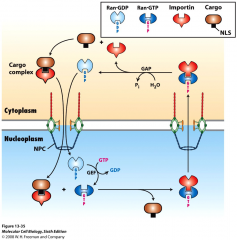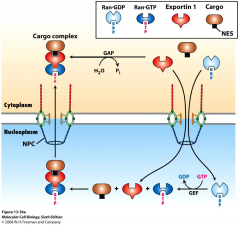![]()
![]()
![]()
Use LEFT and RIGHT arrow keys to navigate between flashcards;
Use UP and DOWN arrow keys to flip the card;
H to show hint;
A reads text to speech;
14 Cards in this Set
- Front
- Back
|
What is the next step once mRNA has been processed? |
Move mRNA into cytoplasm where it can be translated for a protein products. RNA Pol II has discrete pockets which are hotbeds for transcription because there are lots of proteins. Need to go through nucleus envelope to move to cytoplasm. |
|
|
What are nuclear pore complexes? |
They resemble baskets and are the sites of nucleocytoplasmic transport. Basically makes a hole in nuclear envelope so things can go in and out. Octogonal shapes are direct link to nucleoplasm from cytoplasmic side, and basket structures from nucleoplasmic side. Incredibly conserved and 30x bigger than ribosome, so is hard to isolate intact. Composed of 50-100 proteins that form structures that allow and restrict molecules. Small stuff moves freely by concentration gradient, big stuff needs active transport (>40-60 kDa) |
|
|
What is the structure of the nuclear pore complex? |
Outer and inner nuclear membrane have lumen in between which has to be sealed off. Has components that are structural that seal nuclear envelope to provide support and rigidity. We are left with a hole of a certain size, structure and fucntion. |
|
|
What does transport through the NPC depend on? |
FG nucleoporins which are hydrophobic, occupy central space and provide gel like matrix that controls flow. Proteins have hydrophillic regions but have FG regions of hydrophobic nucleotides called FG repeats. Hydrophobic regions interact together to make meshwork inside the central pore, need to make way through mesh by use of transporter that has hydrophobic repeats on it which interact with repeats in hydroporins and allow molecule to get through. |
|
|
How are proteins imported through the NPC? |
Remember: all proteins are synthesized in the cytoplasm. Get in nucleus using a nuclear localization signal. It is a sequence in the protein that allow for recognition by the transporter. Can be at C or N terminus. Necessary for nuclear localization. Addition of NLS to protein targets it for the nucleus. |
|
|
What proteins are required for nuclear import? |
Ran: a monomeric G protein, exists in 2 conformations, one bound to GTP (active) and one to GDP (inactive). Acts like a switch. Regulators: -GTPase: wants to hydrolyse GTP -GAPs encourage it to hydrolyse and go to inactive form- inhibitor -Guanine exchange factors: take inactive forma and substitute to create active form |
|
|
What are nuclear transport receptors? |
Importins. Bind to NLS domains present on cargo proteins to facilitate transport through the pore by association with FG nucleoporins. |
|
|
What is the mechanism for nuclear transport? |

-Cargo complex formed by cargo and importin which interacts with FG repeats, go through nuclear pore into nucleoplasm as a bimolecular complex -when it arrives, it finds Ran GTP, interacts to change conformation of importin and cargo released -cytoplasmic filaments have inhibitors that encourages Ran to hydrolyse to GTP that releases importin and continue the cycle. -high importin concentration in cytoplasm encourages unidirectional transport |
|
|
What is Ran-dependent nuclear Export? |

-moving things out of the nucleus -also proteins that have to go in and out must have both NES and NLS -uses conformational changes to drive assosciations and dissosciation of cargo to the receptor-exportin -also uses Ran-GTP and Ran GDP again. Forms trimolecular complex of cargo so you have cargo, exportin and Ran GTP entering nucleopore - GAP at filaments results in hydrolysis of Ran GTP to Ran GDP, changes conformation, releases exportin and exportin releases cargo, then the components can be brought back in to the nucleoplasm if neccesary -high concentration of cargo on nucleoplasm site, unidirectional flow |
|
|
How are some RNAs exported by associating wits Ran? |
Exportin t exports tRNAs. It binds fully processed tRNAs and Ran GTP and passes through NPCs. The complex dissociates in the cytosol when it interacts with Ran GAP. Export of ribosomal subunits requires Ran. Some specific mRNAs that associate with particular hnRNP (like HIV rev) can be exported this way. Most mRNAs are exported in ran independent precesses using an mRNA exporter. |
|
|
What is the mRNA exporter? |
An alternative to importin and exportin, but requires energy. Consists of Nxf1 and Nxt1 subunits. Together they bind RNA with specific mRNP proteins including the SR proteins (splicing factors giving direction). They form a domain that interacts with FG repeats in FG nucleoproteins. Transport of mRNP through the NPC is ran independent. |
|
|
What is the model of mRNP transport? |

-exporter binds to transcript, interacts with FG repeats in nuclear pore, moves through complex -filaments are associated with Dbp5 -uses ATP to unwind mRNA and unwind Nxf1 and Nxt1 and release them -they can be reimported |
|
|
How can mRNA export be visualised? |
ie. insect polytene chromosomes provide a system where transcription and mRNA export can be microscopically imaged Morphological change that groups mRNP. Since ribosomes associate with the mRNA while it is still being exported, the 5' end must be exported first. This gives polarity to movement of transcript. |
|
|
Why are pre-mRNAs excluded from the export system? |
Some kind of signal. Only fully spliced, mature mRNAs get exported; mechanisms of this restriction are not fully understood. May be associated with the activity of a protein bound to a nucleoporin that actively blocks pre-mRNAs from leaving the nucleus. |

